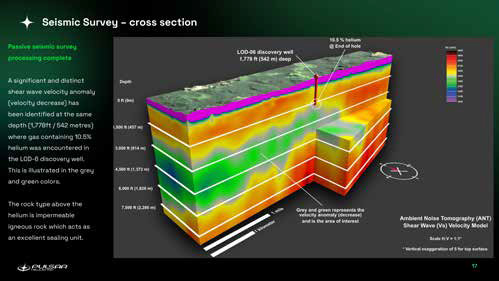History was made earlier this year when Pulsar Helium drilled their Jetstream 1 appraisal borehole near Babbitt and collected natural gas samples with up to 13.8% helium concentrations.
The historic discovery, which took place in February, is considered one of the highest concentrations of helium ever found in nature.
Depending on how large the underground helium reserve is, the Iron Range may have a golden opportunity to add a significant boost to its economy by extracting the helium.
Helium on the Iron Rang is a new concept, and many people are unfamiliar with how helium was discovered here in the first place, or why it is important.
The story begins in 2011 when Phil Larson, now project advisor for Pulsar Helium, was working with a copper-nickel exploration program doing test drills near Babbitt.
“One day, we hit a pressurized gas pocket. It was a lot of pressure and blew the core tube out of the drill stream,” said Larson. “The gas flowed for four or five days while we were carefully trying to figure out exactly what we were dealing with.”
Initially, there was concern the gas pouring out of the hole was explosive, but that didn’t turn out to be the case.
The exploration team was able to fill the hole back in after around five days, but not before collecting a few small samples of the gas.
“We walked away from the hole as it was not part of what we were targeted or even had a lease to do,” said Larson.
The crew didn’t think much about it until the tests came back with composition reports for the gas.
The gas was a mixture of carbon dioxide, nitrogen, methane, and the tests showed 10.5% helium.
“At the time, we were just kind of scratching our heads, not appreciating what that meant,” said Larson.
There have been only two other documented cases of 10% or more concentrations of helium in a gas pocket in North America.
“Only after the hole was sealed, we started reviewing the information and realized, “Oh, wow, that actually is, that’s pretty high. There potentially something there,” said Larson.
A pocket of gas yielding 10.5% helium is extraordinary, but when Pulsar Helium drilled their appraisal borehole in February, they didn’t find 10.5% helium concentrations. They found 13.8% helium concentrations.
“Comparing this to our extensive database for helium occurrences around the world, we are pleased to say the results from the Jetstream #1 appraisal well are the highest helium concentrations that we have ever seen,” said Cliff Cain, CEO of the Edelgas Group (an international gas advisor firm that is engaged by Pulsar).
While the revelation of 13.8% helium concentrations is great news, Pulsar Helium needs to conduct pressure and flow testing to determine if the size of the helium pocket is big enough to be economical to extract.
Due to abnormally high winter temperatures and the earlier-than-anticipated onset of spring load restrictions on local roads, the well-testing package that includes flow testing, a pressure build-up program, and the collection of pressurized gas samples for laboratory analysis, has been delayed longer than anticipated.
Pulsar Helium is hopeful to be able to conduct the pressure and flow tests soon to see if they will be able to build a helium processing plant for extraction.
Currently, most helium is extracted as a by-product of gas production and usually accounts for less than 1% of the composition of these gas mixtures.
There are only a handful of helium explorers looking for primary helium sources, and a developing helium shortage in the U.S. and globally has led to massive price increases with no signs of stopping.
The shortage has gotten to a point where the federal government has been winding down its strategic helium reserve.
Pulsar Helium hopes its discovery could help alleviate the shortage, and the DNR estimated they could extract up to $1 million a day from the gas pocket.
Most know helium as the gas in balloons at a child’s birthday party, but helium is much more than a toy.
Helium is one of the leading atmospheric gases used in the technology industry and is irreplaceable in manufacturing many everyday items.
A large obstacle Pulsar Helium has yet to face is what kind of taxes and legislation it must face from the Minnesota government.
“The discovery of this deposit is an exciting opportunity for northern Minnesota to once again become a domestic source for a critical mineral, and this legislation makes sure the state is ready to capitalize,” said senator Grant Hauschild (DFL-Hermantown). “Now it is up to us as policymakers to move with urgency, get this legislation passed, and prepare for the future work we need to do to make Minnesota a global leader in helium extraction.”
Following the discovery, new legislation introduced by Hauschild wants to establish the policy framework necessary for helium exploration in Minnesota immediately and set up an advisory council to create a long-term oversight framework for this new opportunity.
“While this is an exciting opportunity, without a framework our local communities, our schools, and our residents will not see the benefits,” said Hauschild. “It’s important to get this right and ensure that our communities in northern Minnesota receive the net benefits of this newly discovered deposit.”
Hauschild’s bill sets up a temporary regulatory framework that takes effect immediately following enactment while requiring the DNR and other relevant agencies to undergo rule making to further develop regulatory expectations within 24 months.
With any luck, the Helium will be economical to mine, and the state regulations and taxes won’t cripple Pulsar Helium’s ability to be profitable.
President of Pulsar Helium, Thomas Abraham- James, said that if they do reach the extraction stage and can comply with all regulations, he is steadfast in his commitment to hire local labor under the circumstance they build a helium processing plant.
“We already have that highly skilled workforce. We certainly wouldn’t be looking at bringing in any foreign labor,” said Abraham-James. “With that brings every advantage under the sun. You’re not looking at relocating people’s special packages or anything like that. You’re looking at using that local workforce that already exists.”

The results of Pulsar Helium’s seismic survey, which indicate that the size of the gas pocket beneath their drill pad could hold a large quantity of helium.
.jpg)









